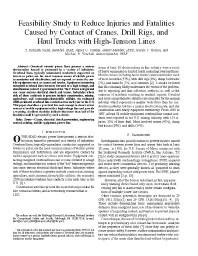Mining Publication: Feasibility Study to Reduce Injuries and Fatalities Caused by Contact of Cranes, Drill Rigs, and Haul Trucks with High-Tension Lines
Original creation date: May 2001
Authors: HK Sacks, JC Cawley, GT Homce, MR Yenchek
NIOSHTIC2 Number: 20021860
IEEE Trans Ind Appl, 37(3), 2001 (May/June); :914-919
Overhead electric power lines present a serious electrocution hazard to personnel in a variety of industries. Overhead lines, typically uninsulated conductors supported on towers or poles, are the most common means of electric power transmission and distribution, and are exposed to contact by mobile equipment such as cranes and trucks. Equipment contacting energized overhead lines becomes elevated to a high voltage, and simultaneous contact by personnel of the "hot" frame and ground can cause serious electrical shock and burns. Industries where risk of these accidents is greatest include construction, mining, agriculture, and communications/public utilities. An estimated 2300 accidental overhead line contacts occur each year in the U.S. This paper describes a practical low-cost concept to detect actual contact of mobile equipment with a high-voltage line and provide a warning. Accident statistics indicate that more than half of the fatalities could be prevented by such a device.

NIOSHTIC2 Number: 20021860
IEEE Trans Ind Appl, 37(3), 2001 (May/June); :914-919
- An Alarm to Warn of Overhead Power Line Contact by Mobile Equipment
- Effect of Three-Winding Transformer Models on the Analysis and Protection of Mine Power Systems
- Electromagnetic Noise in Robena No. 4 Coal Mine
- Heavy Equipment Near Overhead Power Lines? New Safety Research May Save Your Life: New Safety Research May Save Your Life
- Mine Power Systems
- Noise Exposure and Overhead Power Line (OPL) Safety Hazards at Surface Drilling Sites
- Occupational Electrical Injuries in the United States, 1992-1998, and Recommendations for Safety Research
- A Performance Evaluation of Two Overhead Power Line Proximity Warning Devices
- Protection Against Lightning At Surface And Underground Mining Plants
- Understanding and Quantifying Arc Flash Hazards in the Mining Industry